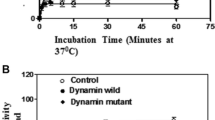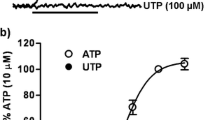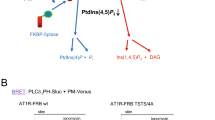Abstract
The opossum kidney (OK) cell line has been shown previously to express endogenous 5-HT1B receptors which negatively couple to adenylate cyclase. Since other Gi-linked receptors have been shown to inhibit adenylate cyclase and to elevate intracellular calcium concentrations ([Ca2+]i), studies were initiated to determine whether native opossum 5-HT1B receptors could also display dual coupling to these signal transduction mechanisms. Saturation studies using [125I](–)-iodocyanopindolol ([125I]CYP) to radiolabel the 5-HT1B receptor in OK cell membranes (in the presence of 3 µM (–)-isoproterenol to mask β-adrenergic receptors) yielded an equilibrium dissociation constant (pK d) of 10.04 and binding site density (B max) of 55 fmol/mg protein. Exposure of intact OK cells to 5-HT, CP 93,129, a selective rodent 5-HT1B receptor agonist, and (±)-cyanopindolol, a mixed 5-HT1A/1B receptor agonist/antagonist, produced concentration-dependent inhibitions of forskolin (3 µM)-stimulated cAMP accumulation (FSCA; E max=90–95%) and elevations of [Ca2+]i (E max∼200 nM increase above basal levels). Agonist potencies (pEC50) ranged from 9.7 to 8.1 and were comparable between the two second messenger assays, although slightly higher agonist potencies (∼three-fold) were observed in the cAMP assay. GR 127,935, a selective 5-HT1B/1D receptor antagonist, behaved as a strong partial agonist in both the cAMP and calcium assays, with an intrinsic activity of 0.7 relative to 5-HT. Methiothepin, a nonselective 5-HT receptor antagonist, competitively antagonized the inhibitory cAMP response elicited by CP 93,129, yielding an apparent pK b value of 7.3. Methiothepin (10 µM) completely antagonized the stimulatory calcium response evoked by a saturating concentration of CP 93,129 (100 nM). Pertussis toxin pretreatment blocked the CP 93,129-induced inhibition of FSCA and elevation of [Ca2+]i in OK cells, indicating the involvement of Gi/o proteins in transducing these second messenger responses. The agonist properties of (±)-cyanopindolol and GR 127,935 observed in both second messenger assays suggests that a large degree of receptor reserve may be present, even though 5-HT1B receptor expression is low in OK cells. The OK cell line continues to serve as a model system to investigate 5-HT1B receptor-mediated signaling events.
Similar content being viewed by others
Author information
Authors and Affiliations
Additional information
Received: 31 March 1998 / Accepted: 21 July 1998
Rights and permissions
About this article
Cite this article
Zgombick, J., Branchek, T. Native 5-HT1B receptors expressed in OK cells display dual coupling to elevation of intracellular calcium concentrations and inhibition of adenylate cyclase. Naunyn-Schmiedeberg's Arch Pharmacol 358, 503–508 (1998). https://doi.org/10.1007/PL00005285
Issue Date:
DOI: https://doi.org/10.1007/PL00005285




